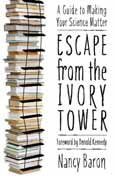SEJournal Online is the digital news magazine of the Society of Environmental Journalists. Learn more about SEJournal Online, including submission, subscription and advertising information.

BookShelf
Escape from the Ivory Tower: A Guide to Making Your Science Matter
By Nancy Baron
Island Press, 2010, $27.50
Reviewed by SUSAN MORAN
Climategate. Global food shortages. Peak oil. The endangered species count on the rise. These are just a few headlines that have emerged or re-emerged in the last couple years, raising public awareness but also creating confusion about the underlying science. The latter consequence underscores the need for scientists to speak out beyond their professional circles to make their research understood and describe why it matters.
In her book Escape From the Ivory Tower: A Guide toMaking Your Science Matter, author Nancy Baron, a communications trainer at the Leopold Leadership Program and COMPASS (Communication Partnership for Science and the Sea) at Stanford University, advises scientists on how to take the leap. In doing so, she argues, they’ll make more people care about science and want to take action. Baron, an SEJ member, offers tips on how to better communicate with journalists as well as policy makers.
Reading her book I felt like I was in the training room at the Leopold Institute, looking around the table at wary scientists who felt burned by journalists like me who took an hour of their time only to quote them briefly, or who were disappointed to see their findings dumbed down in print. These are common, well-founded complaints. What makes Baron’s book important is that she offers step-by-step exercises and advice for scientists who want to deliver their message to a broader audience. A whole section of the book is titled “The How-To Toolkit.” Baron also offers insights that help journalists and scientists better understand their different work cultures — journalists’ deadline and space constraints, for instance.
Some of Baron’s messages apply well to journalists covering science, though they’re nothing we haven’t learned in journalism school or from editors. But they’re worth the reminder: Know your audience. Avoid jargon (say “bottom-dwelling,” not “benthic,” she says). Be succinct. Think in pictures. Baron also invites journalists to offer their advice and lessons learned so that scientists can understand them a little more. One observation that gave me cause for reflection (and a little remorse) was from SEJ member Tom Hayden, a former scientist turned science writer. “An interview between a journalist and a scientist is like a conversation. Or, no, maybe more like a dance, but with each partner trying to lead.” This sure beats the “Can I pick your brain?” interview approach, which is more like brain surgery than a duet, and hardly engenders trust and respect. Hayden’s dance metaphor can apply to reporter-source relationships well beyond science journalism.
So should scientists be activists, and for what? Baron does not say scientists should become activists for a cause. That can tarnish their own and other scientists’ credibility. Rather, Baron argues that “the urgency of climate change, our need for energy alternatives, the degradation of the planet’s life support systems,” and other pressing issues of our day require, more than ever, that scientists offer their expertise to the public, not just to their peers.
Barry Noon, an ecologist at Colorado State University, shares in the book what motivated him to dive into the public policy foray many years ago — a sense of loss over places he enjoyed as a child, and later, anger over how scientific findings based on his and others’ research about spotted owls were distorted by agenda-driven groups and the media. “Scientists have a responsibility to communicate their scientific findings and, when asked, to discuss their policy implications,” he says. “I believe that scientists must find their own comfort zone when it comes to the public communication of science and should not be criticized for their decision.”
Baron’s book is a practical, no-nonsense guide, as the title suggests. It is not as philosophical as, say, Cornelia Dean’s Am I Making Myself Clear? A Scientist’s Guide to Talking to the Public. But I wish university departments would give it to all science undergraduates and especially graduate students to help them learn to think more about the importance of communicating their work outside the comfort zone of academia. Maybe their findings, and their voices in general, would eventually sound above the deafening science deniers in Washington.
Susan Moran is a freelance writer based in Boulder. She recently returned from the Western Antarctic Peninsula’s Palmer Station on a Marine Biological Laboratory fellowship. She was a 2009-2010 Knight Science Journalism Fellow at MIT.
* From the quarterly newsletter SEJournal, Spring 2011 issue.












 Advertisement
Advertisement 



